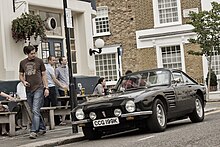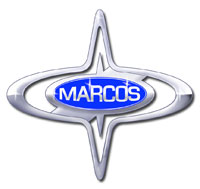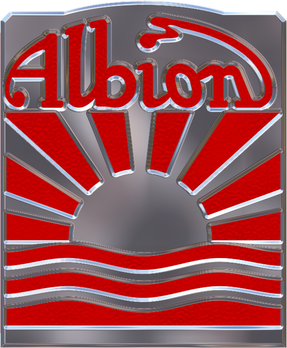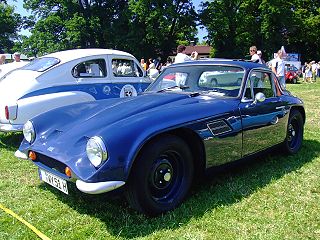History
Roots at TVR

Trident Cars has its origins in a failed project by the sports car manufacturer TVR.
TVR went through a series of bankruptcies and takeovers in the early 1960s. Layton Sports Cars, founded in 1959 and renamed TVR Cars in 1961, was insolvent at the end of 1962 and was dissolved. The newly founded Grantura Engineering Ltd. took its place and continued production of the TVR Grantura at the same Blackpool facilities. At the end of 1965, Grantura Engineering was also insolvent. In addition to the TVR Grantura, the companies also had the Griffith 200 (later 400) in their range, which, with an unchanged body, was equipped with an eight-cylinder V-engine from Ford USA instead of a British four-cylinder engine. It was primarily intended for the North American market.
In 1962, Brian Hopton, one of the owners of TVR Cars, commissioned the British designer Trevor Fiore to design a new body for the Griffith 200. He had previously tried in vain to recruit Frank Costin as a designer. [2] Fiore designed a compact hatchback coupe, of which the Italian Carrozzeria Fissore produced a prototype with an aluminum body and an extended TVR chassis. [3] Fissore presented it as the Trident at the Geneva Motor Show in March 1965. During the course of the year, Fissore built two more prototypes - a coupé and a convertible - but after the bankruptcy of Grantura Cars at the end of 1965, the Trident project was initially discontinued. [4] Arthur and Martin Lilley, who took over the production facilities in Blackpool in November 1965 and incorporated them into the newly founded company TVR Engineering, initially assumed that they would also take over the Trident project. In fact, the British TVR dealer William “Bill” Last had previously acquired the rights to Fiore’s design and the moulds for the Trident body. [2]
Trident Cars

Bill Last founded Trident Cars, initially in Woodbridge, using the premises he previously used for manufacture of the Peel Viking Sport. The company later moved to Ipswich. The newly founded company presented a fourth prototype at the Racing Car Show in Olympia in 1966, but little more was heard until the company presented a fifth prototype, again at Olympia, in 1967. Trident later began series production of the coupé in 1967, largely following Trevor Fiore's prototypes in terms of style. Over the years, different six and eight cylinder engines of British and US origin were installed; the respective vehicles were given different model names. [5] In 1974, Trident temporarily stopped production. In 1975 the company was restructured. The US investor Ernest Stern took over the majority share. Trident then tried to reach the North American market with a revised version of the Clipper, but nothing came of it and only two cars were built. [6]
Engine problems in the cars, the oil crisis and the financial climate in the 1970s resulted in the company closing down in 1974. An attempt was made to restart production in 1976 but few cars were made before final closure in 1977.
Most sources assume that Trident sold a total of around 130 vehicles from 1967 to 1977, with one source even saying 225 vehicles. [7] The British brand club sets the production figure even lower. By 2016, he had only been able to produce a total of 85 Trident coupés. [8]
Revival

In May 1999 the company was re-established in Fakenham. [9] The first result of this new venture was the prototype of a two-seater spider, the Iceni, which was presented at the Birmingham International Motor Show the following year. [10] [11] [12] . The car featured a 3.2-liter V6 engine. From 2007 the concept was equipped with a 6.6-liter General Motors turbodiesel V8 engine. [13] In 2014 the closed version was presented with the name Iceni Magna. The car has yet to be produced due to funding issues. [14]





















